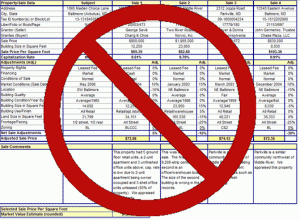I’m not a big fan of the sales comparison approach for marina appraisals. Don’t get me wrong – extracting a cap rate from sales is the best way to get true market derived cap rates. But when it comes to reviewing sales comparisons, it is not an easy job because you don’t have the same checks and balances available as you do the income approach. From Part 6 of this blog series, you even have a check and balance for the cost approach. Not so with the sales comparison.
A Rose is Not a Rose By Any Other Name
 You can say this about a rose, but you can’t say it about a comparable sale. I’ve heard it said on the witness stand that “no two marinas are alike”. Guess what that means in the sales comparison approach? Lots of adjustments frequently without support. Nothing wrong with that… it goes with the territory for marinas.
You can say this about a rose, but you can’t say it about a comparable sale. I’ve heard it said on the witness stand that “no two marinas are alike”. Guess what that means in the sales comparison approach? Lots of adjustments frequently without support. Nothing wrong with that… it goes with the territory for marinas.
The biggest and most important factor in a marina sales comparison approach is picking comparables from the same market tier. The boat dealership sale makes a lousy comparable for a basic marina and vice versa. Some comparables are so unique there is nothing like them, such as the marina with a large motel yet no repair facility. I doubt too many people would argue that the typical buyer for a boat dealership is a boat dealer whereas the typical buyer for a basic marina is not a boat dealer. Different buyers mean different markets. They are no more interchangeable than the buyers for Chevrolets and BMWs. You need to have a really good reason for including marinas from different market tiers in a sales comparison approach and it needs to be spelled out in the report.
I Will Count If You Double Count
Some adjustments just conflict. Adjusting for land size and parking is the most obvious. Adjusting for the marina office is another. Adjusting for services is a further example; most services are rendered in buildings and you’re already adjusting for that. Lineal foot of dock space and number of slips shouldn’t be together on the same adjustment grid. And so on.
Bigger is Not Better
In the world of sales comparison adjustments, bigger is not better. One aspect is how large an individual adjustment is. Another is the total amount of adjustment (i.e. the net adjustment). A third is the magnitude of adjustment. These three combine to help the reviewer determine how comparable a marina is to the subject; lots of adjustments, large adjustments or large net adjustments signal that the comparable may not be comparable.
What Is The Meaning Of This?
So you’re adjusting for quality. Quality of what? The buildings? The docks? Couldn’t the two be going in opposite directions? Same for condition: specify. Which brings me to my next topic…
What Were They Thinking?
One question I frequently pose when reviewing a marina sales comparison approach is would the market react to that feature? Another is whether that feature affects market value or just marketability. Amenity buildings are a good example. Does the open air pavilion really count? How about differences in building size? Which buildings warrant a size adjustment? Does a market participant really believe that 5 percent of the marina should be adjusted because it has a different type of sewer pumpout system? Would a market participant really put that much value on land that is likely wetlands or has soil that would sink if you parked a boat on it?
Did We Not List the Listings?
I like to see discussions of listings. If they’re not available, just say so. There is nothing so disheartening as going to LoopNet.com or CoStar.com and finding a better marina in the same market listed for less. Small red flags are OK – big ones are not.
Yo-Yos Are For Kids
Did I forget to mention that adjustment grids are not done by some appraisers? I’m not specifically referring to marina adjustment grids, but a business practice of not including them in the report. Instead what we typically see is a diatribe about each sale. This sale is superior for x, it was inferior for y and superior for z. Then on to the next sale where we go back and forth, up and down. Watching a yo-yo gets me dizzy. So does trying to figure out the magnitude of all the adjustments to a sale without an adjustment grid.
Conclusion
Hopefully the appraiser concluded within the range of the sales and if not, did a good job of explaining why not. Averaging the adjusted net sale prices per unit is a no-no. How great is the adjusted range? How much smaller is it from the range before adjustments? Do the pictures support the adjustments?
Sometimes we see conclusions that are PFA – Plucked From Air. It’s as if there was a circular motion of the magic wand and poof! There’s the price per slip. If you’re going to use a magic want or genie in a bottle, make a pile of cash instead. This way I don’t have to read it.
The final part of this series will discuss reviewing the Income Approach.

